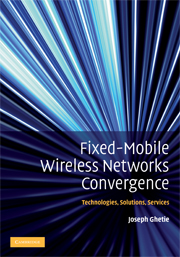Book contents
- Frontmatter
- Contents
- Disclaimer
- How the Book is Organized
- List of Figures
- List of Tables
- Preface
- Acknowledgments
- Acronyms
- Part I Wireless Communications: Networking and Management
- Part II Cellular Mobile Radio Networking and Management
- Part III Fixed Wireless Technologies: Networking and Management
- Part IV Fixed Wireless Cellular Mobile Networks Convergence and Integration
- 10 Fixed-Mobile Convergence Overview
- 11 Wireless LAN Cellular Mobile Convergence
- 12 Wireless PAN Cellular Mobile Convergence
- 13 Wireless MAN Cellular Mobile Convergence
- 14 Wireless Sensor Networks Cellular Mobile Convergence
- Part V Fixed Wireless Cellular Mobile Networks Convergence: Standardized Networking Solutions
- Part VI Fixed-Mobile Convergence Services, Industry Trends, and Implementation Issues
- References
- Index
12 - Wireless PAN Cellular Mobile Convergence
from Part IV - Fixed Wireless Cellular Mobile Networks Convergence and Integration
Published online by Cambridge University Press: 21 August 2009
- Frontmatter
- Contents
- Disclaimer
- How the Book is Organized
- List of Figures
- List of Tables
- Preface
- Acknowledgments
- Acronyms
- Part I Wireless Communications: Networking and Management
- Part II Cellular Mobile Radio Networking and Management
- Part III Fixed Wireless Technologies: Networking and Management
- Part IV Fixed Wireless Cellular Mobile Networks Convergence and Integration
- 10 Fixed-Mobile Convergence Overview
- 11 Wireless LAN Cellular Mobile Convergence
- 12 Wireless PAN Cellular Mobile Convergence
- 13 Wireless MAN Cellular Mobile Convergence
- 14 Wireless Sensor Networks Cellular Mobile Convergence
- Part V Fixed Wireless Cellular Mobile Networks Convergence: Standardized Networking Solutions
- Part VI Fixed-Mobile Convergence Services, Industry Trends, and Implementation Issues
- References
- Index
Summary
Bluetooth Networking
In Chapter 7 we introduced the WPAN infrastructure and Bluetooth, a technology that supports short range communications and home networking. Initially, Bluetooth's primary function was “cable replacement”, i.e., elimination of short-range wired-based communications. Therefore, most of the Bluetooth applications presented were based on point-to-point and point-to-multipoint wireless links. However, the applicability of Bluetooth has gradually extended, covering various aspects of office automation, industrial process automation, and even mobile ad-hoc networking. Many of these extensions include Mobile-to-Mobile (Mo2Mo) networking, beyond the traditional clustering within piconets. An essential condition of Bluetooth networking is its ability to work in extended ranges, up to 1 km, using omnidirectional antennas. Another condition is low power consumption while maintaining a high data rate. The Bluetooth networking architecture is shown in Figure 12.1.
Bluetooth networks consist of multiple piconets interconnected into larger scatternets, providing a community area network of multiple groups of users. A piconet consists of a single Master Station (MS) and several Bluetooth (B)-enabled devices. Sophisticated home networks can be organized as scatternets where each piconet represents an ad-hoc grouping of Bluetooth-enabled devices with common functionality such as environmental automation, audio/visual systems, and computing systems.
Within a piconet, the master station establishes connections with all the Bluetooth devices, including a smart cell phone that can provide connectivity to a mobile service provider and the Internet. Within scatternets, Bluetooth connections are established between master stations to allow multi-hop routing.
- Type
- Chapter
- Information
- Fixed-Mobile Wireless Networks ConvergenceTechnologies, Solutions, Services, pp. 238 - 255Publisher: Cambridge University PressPrint publication year: 2008



